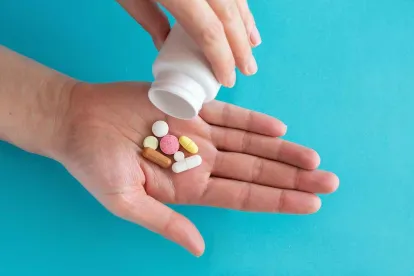In BMS v. Sigmapharm Labs. LLC., --F.3d __ (Fed. Cir. Sept. 3, 2021) the Federal Circuit affirmed the district court decision holding the asserted claims of U.S. Patent Nos. 6,967,208 and 6,967,945 infringed and not invalid. In particular, the Federal Circuit affirmed the district court’s claim construction of the terms “apixaban particles have a D90equal to or less than about 89 microns,” and “crystalline apixaban particles.” Judge Stark’s claim construction of these limitations was key because the defendants contested infringement specifically of these two limitations.
Background
BMS sued Sigmapharm Labs. and other generic manufacturers for infringement of U.S. Pat. Nos. 6,967,208 (“the ’208 patent) and 6,967,945 (“the ‘945 patent) under the Hatch-Waxman Act. The ‘208 patent claims the compound apixaban and the ’945 patent claims apixaban formulations. Apixaban is the active ingredient in BMS’s commercially successful drug Eliquis®.
BMS asserted claims 13 and 104 of the ’208 patent against Sigmapharm and Unichem. Claim 13 recites:
A compound according to claim 8 [see below], wherein the compound is:
1-(4-methoxyphenyl)-7-oxo-6-[4-(2-oxo-1-piperidinyl)phenyl]-4,5,6,7-tetrahydro-1H-pyrazolo[3,4-c]pyridine-3-carboxamide
or a pharmaceutically acceptable salt form thereof.
That is, claim 13 recites apixaban or a pharmaceutically acceptable salt form of apixaban. Claim 104 of the ’208 patent recites:
A compound according to claim 13 [recited above], which is a crystalline compound.
Non-asserted claim 8, from which claim 13 depends, recites “[a] compound according to claim 1, wherein the compound is selected from [41 chemical compounds] or a pharmaceutically acceptable salt form thereof.” Non-asserted claim 1, from which claim 8 depends, recites a structure that includes many chemical compounds, one of which is apixaban.
BMS asserted claims 21 and 22 of the ’945 patent against Sigmapharm, Sunshine Lake, and Unichem. Claims 21 and 22 depend from independent claim 12, reproduced below.
12. A solid pharmaceutical composition comprising a therapeutically effective amount of apixaban and a pharmaceutically acceptable diluent or carrier,
-
wherein apixaban comprises crystalline apixaban particles,
-
wherein the crystalline apixaban particles have a D90equal to or less than about 89 μm, and
-
wherein, as measured using a USP Apparatus 2 at a paddle rotation speed of 75 rpm in 900 ml, of a dissolution medium at 37° C., at least 77 wt % of apixaban in the pharmaceutical composition dissolves within 30 minutes in the dissolution medium, and the dissolution medium is 0.05 M sodium phosphate at a pH 6.8 containing 0.05% sodium lauryl sulfate.
Asserted claims 21 and 22 depend from claim 12 and add that the compositions comprise 2.5 or 5 mg of apixaban, respectively.
Defendants brought counterclaims of invalidity against the ’208 and ‘945 patents. Specifically, the defendants argued that the ‘208 patent is invalid for improper dependency, lack of enablement, and lack of written description support. The ’945 patent was alleged to be invalid for lack of enablement, lack of written description support, and obviousness.
District Court
After a nine-day bench trial involving numerous expert witnesses, Judge Stark issued a lengthy and detailed opinion holding that that the asserted claims were infringed and not invalid. Bristol-Myers Squibb Co. v. Aurobindo Pharma USA Inc., 477 F.Supp.3d 306, 313 (D. Del. Aug. 5, 2020).
District Court’s Infringement Decision
Sigmapharm’s non-infringement position depended on its allegation that claim 1 of the ’208 patent did not cover apixaban. Id. at 339. According to Sigmapharm, claim 1 “recites that rings M, E, A, and Q are ‘substituted with’ a certain number of R groups: M with 0-2 R1a, E with 1-2 R, A with 0-2 R4, and Q with 0-2 R4a” and that means how many “substituents” can be included in each ring. Id. at 340. “[T]o Sigmapharm, claim 1 requires that ring M contain no more than two hydrogen ‘substituents.’ To Sigmapharm, because it is undisputed that (for example) in apixaban ring M contains more hydrogen atoms than the claim allows, apixaban does not meet the ring M limitation and, it follows, ring M is not covered by claim 1.” Id.
BMS responded:
[T]hese ring limitations specify how many R groups can be replaced in the rings of the claimed chemical structure. For example, to BMS, claim 1 requires that ring M contain 0-2 R1a; so a compound that (in addition to meeting all other claim limitations) contains 0, 1, or 2 R1agroups is within the scope of claim 1.
***
The claim language expressly provides that the M, A, and Q rings can be ‘substituted with’ zero R groups. This plainly means that the claim language covers situations in which zero hydrogens are replaced with R groups.
Id.
The district court agreed with BMS:
The plain and ordinary meaning to a POSA of “substituted with [N] R” is “replaced with [N] R,” where N is a number; it is not “must include [N] hydrogen substituents.” The plain and ordinary meaning of “substituted” is “replaced with.” The claim language, which does not refer to “substituents,” provides no grounds to ignore this plain and ordinary meaning.
Id. Based on that claim construction, the district court determined that BMS showed, by a preponderance of the evidence, that claims 1, 13, and 104 of the ’208 patent do cover apixaban.
Because Sigmapharm’s ANDA product undisputedly contains apixaban, the district court concluded that Sigmapharm’s ANDA product infringes the asserted claims of the ’208 patent. Id. at 342.
The district court also found infringement of the asserted ’945 patent claims based on its claim construction. Id. “BMS proved by a preponderance of the evidence that Sigmapharm’s ANDA product contains crystalline apixaban particles. … Sigmapharm’s experts did not successfully rebut these conclusions and Sigmapharm’s attacks on Plaintiffs’ evidence fail.” Id. at 343. With respect to Sigmapharm’s argument that BMS failed to prove its crystalline apixaban particles have a D90equal to or less than 89 microns, BMS met its burden of proof that it “did not need to measure or calculate precise D90values because Sigmapharm’s manufacturing process makes it impossible for any crystalline apixaban particles in Sigmapharm’s product to have a D90greater than 89 microns.” Id. at 346.
Sigmapharm did not explain “how the crystalline particles in Sigmapharm’s ANDA product could exceed the claimed size limitations given their original size and the constraints imposed by the manufacturing process.” Id. at 347.
The district court concluded that BMS proved by a preponderance of the evidence that the other proposed ANDA products contain crystalline apixaban particles having a D90equal to or less than 89 microns. Id. at 347-351.
District Court’s Validity Decision
Regarding the alleged § 112 deficiencies, Judge Stark held that the asserted ’208 patent claims were enabled and had sufficient written description support. “Example 18 of the ‘208 patent explains how to make apixaban. … The ‘208 patent also explains how to make pharmaceutically acceptable salts of the disclosed compounds.” Id. at 329. Although the synthesis of a pharmaceutically acceptable apixaban salt was not described in the patent, “the Court is persuaded that a POSA would understand from the four corners of the ’208 patent that the inventors possessed pharmaceutically acceptable apixaban salts, notwithstanding that the inventors did not themselves practice these embodiments of their claims.” Id. at 353
The district court also concluded that the asserted claims in the ’945 patent had sufficient enablement and written description support:
The claims cover solid pharmaceutical compositions having crystalline apixaban with the claimed particle size and claimed dissolution rate. …The ’945 patent provides working examples of the claimed solid pharmaceutical composition. … As Dr. Myerson explained, the ’945 patent provides substantial direction to a POSA seeking to practice the asserted claims, including describing methods for formulation and for measuring the particle size of the crystalline apixaban particles, tables demonstrating the dissolution rate of different compositions having the proper particle size, and examples of solid pharmaceutical compositions that meet the claim limitations. … [A]s BMS correctly states, “by measuring the D90of the crystalline apixaban before formulation (and ensuring it was within the claimed particle size distribution), a POSA would have known that the crystalline apixaban in the final composition would be within the claimed D90threshold.
Id. at 333. The district court also agreed with BMS that undue experimentation would not be required for a POSA to determine if the crystalline apixaban in the formulated tablet is within the claims, pointing to the example in the specification that measured D90of apixaban via laser light scattering priori to dry granulation. Id.
Regarding the alleged § 103 issues, Judge Stark held that the prior art relied upon by defendants would not have provided motivation to “(1) arrive at the target dissolution rate in the ’945 patent or (2) select a D90of 89 microns or less.” Id. at 337. Specifically, general suggestions about pharmaceutical development were deemed insufficient to show the requisite motivation to combine or modify the prior art to achieve the claimed invention. Id. at 355.
Federal Circuit
In a one paragraph decision, the Federal Circuit complimented and affirmed the lower court decision, specifically noting its adoption of the court’s claim constructions.
Take-aways
Patent litigation is often dependent on expert testimony, analyses, and experiments. The lower court decision and subsequent Federal Circuit affirmance demonstrate the importance of expert testimony. These decisions serve as excellent examples of the detail-oriented nature of complex drug U.S. patent applications, their prosecution, and their litigation, particularly in the ANDA context.
Stacy Lewis also contributed to this article.






 />i
/>i

